Northeastern Peloponnese, southern Greece.The magic of the shores of the Argolid, the bald moun tains, golden valleys, the grandeur of the monuments and the eternal quality of its myths will leave a lasting impression. Ïn this "flaming red Argive earth" celebrated by the poet, "where the poppy flames still brighter", you hear the most sublime voices of the Greek land - Homer, Aeschylus, Sophocles. 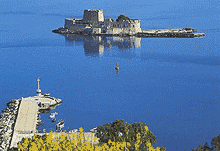
The Argolid was the heart of Greece from 1600 to 1100 BC under the Mycenaeans. With their decline, the Dorians controlled the fate of the region until the åïç- quest of the country by the Romans. During the Byzantine era the Argolid shared the fortune of the rest of the Peloponnese. It was ruled by the Franks and surrendered to the Turks in 1460, Nafplio, however, remained in Venetian hands until 1540.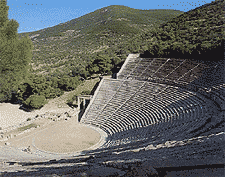 Nafplio was the capital of the newly formed Greek state from 1828 to 1834, when this role passed to Athens. The district in this little tour the approach to the district of Argos starts in the south, at Arcadian Astros. The little village of Mili is not far away. Ten kilometres further north are the ruins of ancient Lerna, where Herakles is said to have killed the Hydra, a dragon with the body of a snake and nine heads. Passing sometimes through valleys filled with vines and olive groves sometimes along the turquoise sea, the road leads to Nea Kios, a coastal town built at the back of the bay of Nafplio. Tranquillity reigns ïn this sandy, shallow seashore. Here ïn the last Sunday before Lent there is a festival with free food and wine. The coast road continues to Nauplia (Nafplio), capital of the prefecture and one of the lovellest towns in all Greece. The old city with its neoclassic houses, picturesque streets, wooden balconies with cascading flowers, Turkish fountains, Constitution (Syntagma) Square with its fascinating mosques and outdoor cafe tables is like a fairy land. Here, after centuries of struggle, happiness has finally settled. You feel like immersing yourself in its history, burrowing into its past-the house of the Regent Mauer, the Military Academy, it operates as a military Museum, the Army Ministry, Greece's first high school, Parliament House, St. Spyridon's, the church where Kapodistrias, the first governor of Greece, was assassinated.
Nafplio was the capital of the newly formed Greek state from 1828 to 1834, when this role passed to Athens. The district in this little tour the approach to the district of Argos starts in the south, at Arcadian Astros. The little village of Mili is not far away. Ten kilometres further north are the ruins of ancient Lerna, where Herakles is said to have killed the Hydra, a dragon with the body of a snake and nine heads. Passing sometimes through valleys filled with vines and olive groves sometimes along the turquoise sea, the road leads to Nea Kios, a coastal town built at the back of the bay of Nafplio. Tranquillity reigns ïn this sandy, shallow seashore. Here ïn the last Sunday before Lent there is a festival with free food and wine. The coast road continues to Nauplia (Nafplio), capital of the prefecture and one of the lovellest towns in all Greece. The old city with its neoclassic houses, picturesque streets, wooden balconies with cascading flowers, Turkish fountains, Constitution (Syntagma) Square with its fascinating mosques and outdoor cafe tables is like a fairy land. Here, after centuries of struggle, happiness has finally settled. You feel like immersing yourself in its history, burrowing into its past-the house of the Regent Mauer, the Military Academy, it operates as a military Museum, the Army Ministry, Greece's first high school, Parliament House, St. Spyridon's, the church where Kapodistrias, the first governor of Greece, was assassinated. 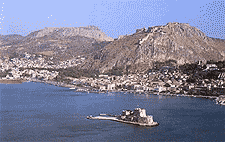 And the fairy tale worid continues, whether you climb onthe 857 steps to the Venetian fortress of Palamidi. It is a narrow, mountainous peninsula projecting eastward into the Aegean Sea between the Saronic Gulf, (to the northeast) and the Gulf of Argolis (to the southwest). Bordered on the north by Korinthos (Corinth) and on the west by the mountains of Arcadia, it has been inhabited since Neolithic times. A limestone plateau comprises the highland areas of Argolis, while its lowland plain is alluvial and fertile, though too dry to cultivate without irrigation. The main natural vegetation is macchie, but with cultivation the land supports vegetables, olives, citrus, and grapes. On the coast trees are cultivated for resin. Goats and sheep are raised, especially for milk, which is used in the production of cheese. The Argolid is an archaeological treasure house and thus a tourist trade centre: Mycenae was the home of Agamemnon, Tiryns the birthplace of Heracles, Epidaurus the home of an ancient healing cult. In ancient times the Gulf of Argolis gave Greece access to trade and exchange of ideas from Crete and Egypt. The city of Argos gave its name to the plain; Nauplia, the chief town of the nomós, is a seaport and seaside resort. It was also the first capital of an independent Greece in the 19th century. Area 2,214 square km.
And the fairy tale worid continues, whether you climb onthe 857 steps to the Venetian fortress of Palamidi. It is a narrow, mountainous peninsula projecting eastward into the Aegean Sea between the Saronic Gulf, (to the northeast) and the Gulf of Argolis (to the southwest). Bordered on the north by Korinthos (Corinth) and on the west by the mountains of Arcadia, it has been inhabited since Neolithic times. A limestone plateau comprises the highland areas of Argolis, while its lowland plain is alluvial and fertile, though too dry to cultivate without irrigation. The main natural vegetation is macchie, but with cultivation the land supports vegetables, olives, citrus, and grapes. On the coast trees are cultivated for resin. Goats and sheep are raised, especially for milk, which is used in the production of cheese. The Argolid is an archaeological treasure house and thus a tourist trade centre: Mycenae was the home of Agamemnon, Tiryns the birthplace of Heracles, Epidaurus the home of an ancient healing cult. In ancient times the Gulf of Argolis gave Greece access to trade and exchange of ideas from Crete and Egypt. The city of Argos gave its name to the plain; Nauplia, the chief town of the nomós, is a seaport and seaside resort. It was also the first capital of an independent Greece in the 19th century. Area 2,214 square km.

The Argolid was the heart of Greece from 1600 to 1100 BC under the Mycenaeans. With their decline, the Dorians controlled the fate of the region until the åïç- quest of the country by the Romans. During the Byzantine era the Argolid shared the fortune of the rest of the Peloponnese. It was ruled by the Franks and surrendered to the Turks in 1460, Nafplio, however, remained in Venetian hands until 1540.
 Nafplio was the capital of the newly formed Greek state from 1828 to 1834, when this role passed to Athens. The district in this little tour the approach to the district of Argos starts in the south, at Arcadian Astros. The little village of Mili is not far away. Ten kilometres further north are the ruins of ancient Lerna, where Herakles is said to have killed the Hydra, a dragon with the body of a snake and nine heads. Passing sometimes through valleys filled with vines and olive groves sometimes along the turquoise sea, the road leads to Nea Kios, a coastal town built at the back of the bay of Nafplio. Tranquillity reigns ïn this sandy, shallow seashore. Here ïn the last Sunday before Lent there is a festival with free food and wine. The coast road continues to Nauplia (Nafplio), capital of the prefecture and one of the lovellest towns in all Greece. The old city with its neoclassic houses, picturesque streets, wooden balconies with cascading flowers, Turkish fountains, Constitution (Syntagma) Square with its fascinating mosques and outdoor cafe tables is like a fairy land. Here, after centuries of struggle, happiness has finally settled. You feel like immersing yourself in its history, burrowing into its past-the house of the Regent Mauer, the Military Academy, it operates as a military Museum, the Army Ministry, Greece's first high school, Parliament House, St. Spyridon's, the church where Kapodistrias, the first governor of Greece, was assassinated.
Nafplio was the capital of the newly formed Greek state from 1828 to 1834, when this role passed to Athens. The district in this little tour the approach to the district of Argos starts in the south, at Arcadian Astros. The little village of Mili is not far away. Ten kilometres further north are the ruins of ancient Lerna, where Herakles is said to have killed the Hydra, a dragon with the body of a snake and nine heads. Passing sometimes through valleys filled with vines and olive groves sometimes along the turquoise sea, the road leads to Nea Kios, a coastal town built at the back of the bay of Nafplio. Tranquillity reigns ïn this sandy, shallow seashore. Here ïn the last Sunday before Lent there is a festival with free food and wine. The coast road continues to Nauplia (Nafplio), capital of the prefecture and one of the lovellest towns in all Greece. The old city with its neoclassic houses, picturesque streets, wooden balconies with cascading flowers, Turkish fountains, Constitution (Syntagma) Square with its fascinating mosques and outdoor cafe tables is like a fairy land. Here, after centuries of struggle, happiness has finally settled. You feel like immersing yourself in its history, burrowing into its past-the house of the Regent Mauer, the Military Academy, it operates as a military Museum, the Army Ministry, Greece's first high school, Parliament House, St. Spyridon's, the church where Kapodistrias, the first governor of Greece, was assassinated.  And the fairy tale worid continues, whether you climb onthe 857 steps to the Venetian fortress of Palamidi. It is a narrow, mountainous peninsula projecting eastward into the Aegean Sea between the Saronic Gulf, (to the northeast) and the Gulf of Argolis (to the southwest). Bordered on the north by Korinthos (Corinth) and on the west by the mountains of Arcadia, it has been inhabited since Neolithic times. A limestone plateau comprises the highland areas of Argolis, while its lowland plain is alluvial and fertile, though too dry to cultivate without irrigation. The main natural vegetation is macchie, but with cultivation the land supports vegetables, olives, citrus, and grapes. On the coast trees are cultivated for resin. Goats and sheep are raised, especially for milk, which is used in the production of cheese. The Argolid is an archaeological treasure house and thus a tourist trade centre: Mycenae was the home of Agamemnon, Tiryns the birthplace of Heracles, Epidaurus the home of an ancient healing cult. In ancient times the Gulf of Argolis gave Greece access to trade and exchange of ideas from Crete and Egypt. The city of Argos gave its name to the plain; Nauplia, the chief town of the nomós, is a seaport and seaside resort. It was also the first capital of an independent Greece in the 19th century. Area 2,214 square km.
And the fairy tale worid continues, whether you climb onthe 857 steps to the Venetian fortress of Palamidi. It is a narrow, mountainous peninsula projecting eastward into the Aegean Sea between the Saronic Gulf, (to the northeast) and the Gulf of Argolis (to the southwest). Bordered on the north by Korinthos (Corinth) and on the west by the mountains of Arcadia, it has been inhabited since Neolithic times. A limestone plateau comprises the highland areas of Argolis, while its lowland plain is alluvial and fertile, though too dry to cultivate without irrigation. The main natural vegetation is macchie, but with cultivation the land supports vegetables, olives, citrus, and grapes. On the coast trees are cultivated for resin. Goats and sheep are raised, especially for milk, which is used in the production of cheese. The Argolid is an archaeological treasure house and thus a tourist trade centre: Mycenae was the home of Agamemnon, Tiryns the birthplace of Heracles, Epidaurus the home of an ancient healing cult. In ancient times the Gulf of Argolis gave Greece access to trade and exchange of ideas from Crete and Egypt. The city of Argos gave its name to the plain; Nauplia, the chief town of the nomós, is a seaport and seaside resort. It was also the first capital of an independent Greece in the 19th century. Area 2,214 square km. Ancient Mycenae
Prehistoric Greek city in the Peloponnese, celebrated by Homer as "broad-streeted" and "golden." According to legend, Mycenae was the capital of Agamemnon, the Achaean king who sacked the city of Troy, and it was set, as Homer says, "in a nook of Argos," with a natural citadel formed by the ravines between the mountains of Hagios Elias (Ayios Ilias) and Zara, and furnished with a fine perennial spring named Perseia after Perseus, the legendary founder of Mycenae. It is the chief Late Bronze Age site in mainland Greece. Systematic excavation of the site began in 1840, but the most celebrated discoveries there were those of Heinrich Schliemann. (For the context of Mycenae in the prehistory of the Aegean area, The term "Mycenaean" is often used in reference to the Late Bronze Age of mainland Greece in general and of the islands except Crete.There was a settlement at Mycenae in the Early Bronze Age, but all structures of that or of the succeeding Middle Bronze Age have, with insignificant exceptions, been swept away by later buildings.
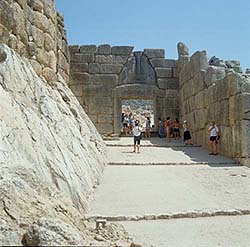 The existing palace must have been reconstructed in the 14th century BC. The whole area is studded with tombs that have yielded many art objects and artifacts. From the Lion Gate at the entrance to Mycenae's citadel, a graded road 3.6 m wide, leads to a ramp supported by a five-terrace wall and thence to the southwestern entrance of the palace. The latter is composed of two main blocks, one originally covering the top of the hill but largely destroyed on the erection of the Hellenistic temple, the other occupying the lower terrace to the south banked up artificially on its western edge. The two blocks were separated by two parallel east-west corridors with storerooms opening off them. The existence of a palace shrine on the upper terrace seems implied by discoveries of a magnificent ivory group consisting of two goddesses and an infant god with fragments of painted tripod altars and other objects.
The existing palace must have been reconstructed in the 14th century BC. The whole area is studded with tombs that have yielded many art objects and artifacts. From the Lion Gate at the entrance to Mycenae's citadel, a graded road 3.6 m wide, leads to a ramp supported by a five-terrace wall and thence to the southwestern entrance of the palace. The latter is composed of two main blocks, one originally covering the top of the hill but largely destroyed on the erection of the Hellenistic temple, the other occupying the lower terrace to the south banked up artificially on its western edge. The two blocks were separated by two parallel east-west corridors with storerooms opening off them. The existence of a palace shrine on the upper terrace seems implied by discoveries of a magnificent ivory group consisting of two goddesses and an infant god with fragments of painted tripod altars and other objects.
At the southwestern corner of the later palace, the west lobby led to the grand staircase of 22 steps, a landing, and another 17 or 18 steps culminating in a small forecourt that afforded entrance to the great court and to a square room immediately to the north of it. There an oblong area with raised plaster border has been interpreted by some scholars as the base for a throne where the king sat in audience. Other scholars, however, have regarded it as a hearth and the room as a guest chamber; the throne might then have stood on the right of the megaron (great central hall), a part that has now disappeared. Both the porch and the main portion of the megaron had floors of painted stucco with borders of gypsum slabs and with frescoes on the walls, one apparently representing a battle in front of a citadel. In the centre was a round plaster hearth enclosed by four wooden columns, possibly implying the existence of a clerestory. The 10 plaster layers of the hearth and 4 of the floor suggest that this hall was in use for a considerable time. The roof was probably flat. East of the corridor lay a series of rooms, the most interesting known from its decoration as "the room of the curtain frescoes." Within the citadel were various houses of retainers. The most imposing, "the house of the columns," rose to three stories in height. South of the grave circle lie the ruins of the "ramp house," the "south house," and the "house of Tsountas." Another building, known as "the granary," from the carbonized barley, wheat, and vetches found in its basement, was erected in the 13th century BC between the Cyclopean citadel wall and one of the grave circles and continued in use up to the destruction of the city by fire about 1100 BC.
The Late Mycenaean period (1400-1100 BC) was one of great prosperity in the Peloponnese. After the destruction of Knossos, on Minoan Crete, Mycenae became the dominant power in the Aegean, where its fleet must have controlled the nearer seas and colonized the Cyclades, Crete, Cyprus, the Dodecanese, northern Greece and Macedonia, western Asia Minor, Sicily, and some sites in Italy. Mycenaean rather than Minoan goods are found in the markets of Egypt, Syria, and Palestine. Mycenaean raiders harried the coasts of the Egyptians and the Hittites, and at a date traditionally supposed to be 1180, but by some scholars now estimated at about 1250 BC, Agamemnon and his followers sacked the great city of Troy. In the 16th century BC, Mycenaean art was temporarily dominated by the influences of Minoan art. Cretan artists must have emigrated to the mainland, and local varieties of all the Minoan arts arose at Mycenae. Minoan naturalism and exuberance were tempered by Greek formality and sense of balance, which were already visible in Middle Helladic painted wares and were later to culminate in the splendid Geometric pottery of the Dipylon cemetery at Athens. (see also Index: Minoan civilization ) Until 1950 Mycenaean literacy was attested only by a few symbols painted on vases; but in 1952 the excavation of "the house of the oil merchant" and "the house of the wine merchant" outside the walls disclosed a number of tablets in the Linear B script first identified at Knossos and later interpreted by the English architect and cryptographer Michael Ventris to be an earlier form of the Greek language. Mycenae was burned and destroyed perhaps by invading Dorians about 1100 BC, but the outer city was not deserted; graves of the Proto-Geometric and Geometric periods have been excavated.
Mycenae evidently continued to exist as a small city-state, and the walls were not pulled down. Early in the 6th century BC a temple, from which one fine relief survives, was erected; in 480 Mycenae sent 400 men to fight against the Persians at Thermopylae, and its men were at Plataea in 479. In 470, however, its aggressive neighbour Argos, which had been neutral in the Persian war, took an ignoble revenge by besieging Mycenae and in 468 destroyed it. In the Hellenistic period Mycenae revived, and a new temple was built on the crown of the acropolis; in 235 BC the Argive tyrant Aristippus was killed there, and the city wall repaired. Nabis of Sparta carried off some of the young men about 195 BC, and an inscription of 194 refers to their detention. A few Roman objects have been found, but, when Greek traveler and geographer Pausanias visited the site about AD 160, he found it in ruins.
 The existing palace must have been reconstructed in the 14th century BC. The whole area is studded with tombs that have yielded many art objects and artifacts. From the Lion Gate at the entrance to Mycenae's citadel, a graded road 3.6 m wide, leads to a ramp supported by a five-terrace wall and thence to the southwestern entrance of the palace. The latter is composed of two main blocks, one originally covering the top of the hill but largely destroyed on the erection of the Hellenistic temple, the other occupying the lower terrace to the south banked up artificially on its western edge. The two blocks were separated by two parallel east-west corridors with storerooms opening off them. The existence of a palace shrine on the upper terrace seems implied by discoveries of a magnificent ivory group consisting of two goddesses and an infant god with fragments of painted tripod altars and other objects.
The existing palace must have been reconstructed in the 14th century BC. The whole area is studded with tombs that have yielded many art objects and artifacts. From the Lion Gate at the entrance to Mycenae's citadel, a graded road 3.6 m wide, leads to a ramp supported by a five-terrace wall and thence to the southwestern entrance of the palace. The latter is composed of two main blocks, one originally covering the top of the hill but largely destroyed on the erection of the Hellenistic temple, the other occupying the lower terrace to the south banked up artificially on its western edge. The two blocks were separated by two parallel east-west corridors with storerooms opening off them. The existence of a palace shrine on the upper terrace seems implied by discoveries of a magnificent ivory group consisting of two goddesses and an infant god with fragments of painted tripod altars and other objects.At the southwestern corner of the later palace, the west lobby led to the grand staircase of 22 steps, a landing, and another 17 or 18 steps culminating in a small forecourt that afforded entrance to the great court and to a square room immediately to the north of it. There an oblong area with raised plaster border has been interpreted by some scholars as the base for a throne where the king sat in audience. Other scholars, however, have regarded it as a hearth and the room as a guest chamber; the throne might then have stood on the right of the megaron (great central hall), a part that has now disappeared. Both the porch and the main portion of the megaron had floors of painted stucco with borders of gypsum slabs and with frescoes on the walls, one apparently representing a battle in front of a citadel. In the centre was a round plaster hearth enclosed by four wooden columns, possibly implying the existence of a clerestory. The 10 plaster layers of the hearth and 4 of the floor suggest that this hall was in use for a considerable time. The roof was probably flat. East of the corridor lay a series of rooms, the most interesting known from its decoration as "the room of the curtain frescoes." Within the citadel were various houses of retainers. The most imposing, "the house of the columns," rose to three stories in height. South of the grave circle lie the ruins of the "ramp house," the "south house," and the "house of Tsountas." Another building, known as "the granary," from the carbonized barley, wheat, and vetches found in its basement, was erected in the 13th century BC between the Cyclopean citadel wall and one of the grave circles and continued in use up to the destruction of the city by fire about 1100 BC.
The Late Mycenaean period (1400-1100 BC) was one of great prosperity in the Peloponnese. After the destruction of Knossos, on Minoan Crete, Mycenae became the dominant power in the Aegean, where its fleet must have controlled the nearer seas and colonized the Cyclades, Crete, Cyprus, the Dodecanese, northern Greece and Macedonia, western Asia Minor, Sicily, and some sites in Italy. Mycenaean rather than Minoan goods are found in the markets of Egypt, Syria, and Palestine. Mycenaean raiders harried the coasts of the Egyptians and the Hittites, and at a date traditionally supposed to be 1180, but by some scholars now estimated at about 1250 BC, Agamemnon and his followers sacked the great city of Troy. In the 16th century BC, Mycenaean art was temporarily dominated by the influences of Minoan art. Cretan artists must have emigrated to the mainland, and local varieties of all the Minoan arts arose at Mycenae. Minoan naturalism and exuberance were tempered by Greek formality and sense of balance, which were already visible in Middle Helladic painted wares and were later to culminate in the splendid Geometric pottery of the Dipylon cemetery at Athens. (see also Index: Minoan civilization ) Until 1950 Mycenaean literacy was attested only by a few symbols painted on vases; but in 1952 the excavation of "the house of the oil merchant" and "the house of the wine merchant" outside the walls disclosed a number of tablets in the Linear B script first identified at Knossos and later interpreted by the English architect and cryptographer Michael Ventris to be an earlier form of the Greek language. Mycenae was burned and destroyed perhaps by invading Dorians about 1100 BC, but the outer city was not deserted; graves of the Proto-Geometric and Geometric periods have been excavated.
Mycenae evidently continued to exist as a small city-state, and the walls were not pulled down. Early in the 6th century BC a temple, from which one fine relief survives, was erected; in 480 Mycenae sent 400 men to fight against the Persians at Thermopylae, and its men were at Plataea in 479. In 470, however, its aggressive neighbour Argos, which had been neutral in the Persian war, took an ignoble revenge by besieging Mycenae and in 468 destroyed it. In the Hellenistic period Mycenae revived, and a new temple was built on the crown of the acropolis; in 235 BC the Argive tyrant Aristippus was killed there, and the city wall repaired. Nabis of Sparta carried off some of the young men about 195 BC, and an inscription of 194 refers to their detention. A few Roman objects have been found, but, when Greek traveler and geographer Pausanias visited the site about AD 160, he found it in ruins.
Epidaurus
The road from Nafplion to Epidaurus (Epidavros) passes through vineyards and age-old olive groves with the mountains looming hazily in the distance, but for Mt. Arahneo, which rises directly above Epldaurus.
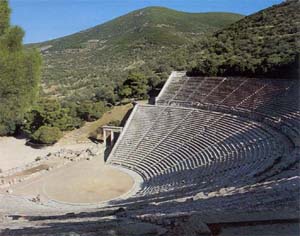 On a hillside, within the sanctuary, lies the theater of Epidaurus (3rd c. BC), the most famous and best preserved of all the ancient theatres in Greece. Built of limestone, it can seat 12,000 spectators.
On a hillside, within the sanctuary, lies the theater of Epidaurus (3rd c. BC), the most famous and best preserved of all the ancient theatres in Greece. Built of limestone, it can seat 12,000 spectators.
Every summer it comes alive. Attending a performance of ancient drama in this theater is almost a mystical experience. Never to be forgotten. A catharsis of the soul.
At Epidaurus the actors don’t need to shout or speak loudly. The acoustics are so perfect that the merest whisper can be heard in the last row.
The entrance to the sanctuary lies to the north of the theater. Asklepios was worshipped here. Though he was a god, Zeus struck him down with his thunderbolt because he wanted to destroy death.
Among the ruins, one can see the foundations of the temple of Asklepios (Doric, 4th c. BC), the guest house, the tholos, the Abaton or sleeping porch, the temples of Artemis and Themis, the gymnasion, etc.
The museum is near the entrance to the site and contains various artifacts plus a helpful model of what the sanctuary must have looked like.
The town of ancient Epidaurus occupied the same location as the present village of Palia Epidavros (Old Epidaurus), a seaside settlement wit a small harbor, nestled in a plain thick with olive and orange trees, rimmed with scenic beaches and several tavernas. Seven kilometers further north, at the foot of Mt. Akros, the road arrives at Nea Epidavros (New Epidaurus), an inland village and then proceeds several kilometers on “to the lonely monastery of Agnounda with its Byzantine frescoes.
West of Nea Epidavros, you come to Ligourio, a modern market town much frequented by tourists.
There are tavern as everywhere you look, and coaches, cars and motorbikes.
Over the wind waft tempting smells of roasting Iamb and kokoretsi.
Theater buffs and lovers of archaeology from all corners of the globe gather here to eat and chat under a starry sky.
Carefree crickets are trilling in the trees.
 On a hillside, within the sanctuary, lies the theater of Epidaurus (3rd c. BC), the most famous and best preserved of all the ancient theatres in Greece. Built of limestone, it can seat 12,000 spectators.
On a hillside, within the sanctuary, lies the theater of Epidaurus (3rd c. BC), the most famous and best preserved of all the ancient theatres in Greece. Built of limestone, it can seat 12,000 spectators.Every summer it comes alive. Attending a performance of ancient drama in this theater is almost a mystical experience. Never to be forgotten. A catharsis of the soul.
At Epidaurus the actors don’t need to shout or speak loudly. The acoustics are so perfect that the merest whisper can be heard in the last row.
The entrance to the sanctuary lies to the north of the theater. Asklepios was worshipped here. Though he was a god, Zeus struck him down with his thunderbolt because he wanted to destroy death.
Among the ruins, one can see the foundations of the temple of Asklepios (Doric, 4th c. BC), the guest house, the tholos, the Abaton or sleeping porch, the temples of Artemis and Themis, the gymnasion, etc.
The museum is near the entrance to the site and contains various artifacts plus a helpful model of what the sanctuary must have looked like.
The town of ancient Epidaurus occupied the same location as the present village of Palia Epidavros (Old Epidaurus), a seaside settlement wit a small harbor, nestled in a plain thick with olive and orange trees, rimmed with scenic beaches and several tavernas. Seven kilometers further north, at the foot of Mt. Akros, the road arrives at Nea Epidavros (New Epidaurus), an inland village and then proceeds several kilometers on “to the lonely monastery of Agnounda with its Byzantine frescoes.
West of Nea Epidavros, you come to Ligourio, a modern market town much frequented by tourists.
There are tavern as everywhere you look, and coaches, cars and motorbikes.
Over the wind waft tempting smells of roasting Iamb and kokoretsi.
Theater buffs and lovers of archaeology from all corners of the globe gather here to eat and chat under a starry sky.
Carefree crickets are trilling in the trees.
City of Nafplio
The city of Nafplio was the first capital of the modern Greek state. Named after Nafplios, son of Poseidon, and home of Palamidis, their local hero of the Trojan war and supposedly the inventor of weights and measures, lighthouses, the first Greek alphabet and the father of the Sophists. The small city state made the mistake of allying with Sparta in the second Messenian War (685-688BC) and was destroyed by Damokratis the king of Argos.
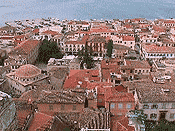 Because of the strength of the fort that sits above the bay, the town of Nafplio became an important strategic and commercial center to the Byzantines from around the Sixth century AD. In 1203 Leon Sgouros, ruler of the city, conquered Argos and Corinth, and Larissa to the north, though it failed to successfully conquer Athens after a siege in 1204.
Because of the strength of the fort that sits above the bay, the town of Nafplio became an important strategic and commercial center to the Byzantines from around the Sixth century AD. In 1203 Leon Sgouros, ruler of the city, conquered Argos and Corinth, and Larissa to the north, though it failed to successfully conquer Athens after a siege in 1204.
With the fall of Constantinople to the Turks, the Franks, with the help of the Venetians captured the city and nearly destroyed the fortress in the process. In the treaty the defenders of the city were given the eastern side of the city, called the Romeiko and allowed to follow their customs, while the Franks controlled the Akronafplia, which was most of the city at the time. The Franks controlled the city for 200 years and then sold it to the Venetians. The Venetians continued the fortification of the upper town and completed their work in 1470. That same year they built a fort on the small island in the center of the harbor called the Bourtzi. To close the harbor the fort was linked by chains and the town was known as Porto Cadenza, meaning Port of Chains. During this period people flocked to the safety of the fortified city in fear of the Turks and forced the expansion of the city into the lagoon between the sea and the walls of the Akronaphlia. The new additions to the city was surrounded with walls and many major buildings were erected including the Church of Saint George. But these new walls didn't matter because in the treaty with Suleiman the First, Nafplio was handed over to the Turks who controlled the city for 100 years and made it the primary import/export center for mainland Greece.
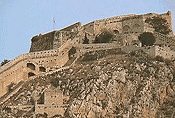 In 1686 the Turks surrendered the city to a combined force of Venetians, Germans and Poles, lead by Vice Admiral Morozini and this began a second period of Venetian rule in which massive repairs were made to the fortress and the city including the construction of the fortress in Palamidi. When the Peloponessos falls to the Venetians, Nafplio becomes the capital. But after just thirty years the Turks once again take control of the city, almost totally destroying it, looting it and killing almost all its defenders. Most of the survivors chose to leave and the city while the Turks built mosques, baths and the homes in the eastern style which can still be seen.
In 1686 the Turks surrendered the city to a combined force of Venetians, Germans and Poles, lead by Vice Admiral Morozini and this began a second period of Venetian rule in which massive repairs were made to the fortress and the city including the construction of the fortress in Palamidi. When the Peloponessos falls to the Venetians, Nafplio becomes the capital. But after just thirty years the Turks once again take control of the city, almost totally destroying it, looting it and killing almost all its defenders. Most of the survivors chose to leave and the city while the Turks built mosques, baths and the homes in the eastern style which can still be seen.
In April of 1821 Greek chieftains and Philhellenes surrounded the city of Nafplio and liberated it from the Turks under the leadership of Theodore Kolokotronis. Naphlion became the center of activities which would result in the formation of Modern Greece.
In 1823 it becomes the capital of the state which is then recognized by the world powers (England, France and Russia) in 1827.
In January of 1828 Ioannis Kapodostrias is recognized as the first governor and arrives in Naphlion. In 1831 King Otto is chosen as the first King of Greece but a month later Kapodostrias is murdered in the Church of Agios Spiridon.
In 1833 King Otto arrives amid great fanfare to the city of Naphlion where he remains until 1834 when the capital of Greece is moved to Athens.
In 1862 there is a rebellion in Nafplio against the monarchy. A siege by the royal army follows. The rebels are given amnesty in 1862. In 1834 Kolokotronis is jailed in the Palamidi fortress.
After the capital moves to Athens, the city of Nafplio becomes of less importance. But it still continues to attract visitors to this very day because it's history is virtually the history of modern Greece and because every occupying power has left it's mark.
The city of Nafplio is like a living museum.
It's also as lively as any city in Greece.
 Because of the strength of the fort that sits above the bay, the town of Nafplio became an important strategic and commercial center to the Byzantines from around the Sixth century AD. In 1203 Leon Sgouros, ruler of the city, conquered Argos and Corinth, and Larissa to the north, though it failed to successfully conquer Athens after a siege in 1204.
Because of the strength of the fort that sits above the bay, the town of Nafplio became an important strategic and commercial center to the Byzantines from around the Sixth century AD. In 1203 Leon Sgouros, ruler of the city, conquered Argos and Corinth, and Larissa to the north, though it failed to successfully conquer Athens after a siege in 1204.With the fall of Constantinople to the Turks, the Franks, with the help of the Venetians captured the city and nearly destroyed the fortress in the process. In the treaty the defenders of the city were given the eastern side of the city, called the Romeiko and allowed to follow their customs, while the Franks controlled the Akronafplia, which was most of the city at the time. The Franks controlled the city for 200 years and then sold it to the Venetians. The Venetians continued the fortification of the upper town and completed their work in 1470. That same year they built a fort on the small island in the center of the harbor called the Bourtzi. To close the harbor the fort was linked by chains and the town was known as Porto Cadenza, meaning Port of Chains. During this period people flocked to the safety of the fortified city in fear of the Turks and forced the expansion of the city into the lagoon between the sea and the walls of the Akronaphlia. The new additions to the city was surrounded with walls and many major buildings were erected including the Church of Saint George. But these new walls didn't matter because in the treaty with Suleiman the First, Nafplio was handed over to the Turks who controlled the city for 100 years and made it the primary import/export center for mainland Greece.
 In 1686 the Turks surrendered the city to a combined force of Venetians, Germans and Poles, lead by Vice Admiral Morozini and this began a second period of Venetian rule in which massive repairs were made to the fortress and the city including the construction of the fortress in Palamidi. When the Peloponessos falls to the Venetians, Nafplio becomes the capital. But after just thirty years the Turks once again take control of the city, almost totally destroying it, looting it and killing almost all its defenders. Most of the survivors chose to leave and the city while the Turks built mosques, baths and the homes in the eastern style which can still be seen.
In 1686 the Turks surrendered the city to a combined force of Venetians, Germans and Poles, lead by Vice Admiral Morozini and this began a second period of Venetian rule in which massive repairs were made to the fortress and the city including the construction of the fortress in Palamidi. When the Peloponessos falls to the Venetians, Nafplio becomes the capital. But after just thirty years the Turks once again take control of the city, almost totally destroying it, looting it and killing almost all its defenders. Most of the survivors chose to leave and the city while the Turks built mosques, baths and the homes in the eastern style which can still be seen.In April of 1821 Greek chieftains and Philhellenes surrounded the city of Nafplio and liberated it from the Turks under the leadership of Theodore Kolokotronis. Naphlion became the center of activities which would result in the formation of Modern Greece.
In 1823 it becomes the capital of the state which is then recognized by the world powers (England, France and Russia) in 1827.
In January of 1828 Ioannis Kapodostrias is recognized as the first governor and arrives in Naphlion. In 1831 King Otto is chosen as the first King of Greece but a month later Kapodostrias is murdered in the Church of Agios Spiridon.
In 1833 King Otto arrives amid great fanfare to the city of Naphlion where he remains until 1834 when the capital of Greece is moved to Athens.
In 1862 there is a rebellion in Nafplio against the monarchy. A siege by the royal army follows. The rebels are given amnesty in 1862. In 1834 Kolokotronis is jailed in the Palamidi fortress.
After the capital moves to Athens, the city of Nafplio becomes of less importance. But it still continues to attract visitors to this very day because it's history is virtually the history of modern Greece and because every occupying power has left it's mark.
The city of Nafplio is like a living museum.
It's also as lively as any city in Greece.

